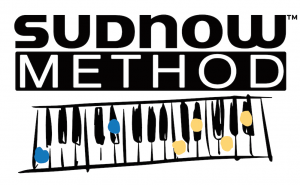I recently slogged through the unexpectedly tedious task of building the dot songs for the new Dot Songbook from David’s original notes. Made somewhat more tedious by my decision to expand the notation and create a better connection to the more typical lead sheet format, I nonetheless often found my mind wandering as I nudged dots around and double checked fractions (not always successfully, as it turns out).
Once completed, I didn’t think much about the dot songs until I was forced to actually use two of them. I belatedly discovered that Suds had not recorded the songs himself and I needed a recorded version to complete the Songbook format I had designed. Thus I sat down at the piano to play them myself. Sort of.
Because I had transposed David’s dots and notes from his original format, I was pretty aware of the atypical things he had done with these songs. My plan was to play from the lead sheet (much easier for me than memorizing the dot songs) and just note where his voicing choices varied from mine. As it turned out, I discovered two things that made that difficult.
First, it became clear to me that I had my own ‘programmed’ voicings for certain chords in certain contexts–and they weren’t always the same as David’s. Second, replacing my thoughtless voicings (meaning I didn’t really think about them, I just played them automatically) with his variations was more difficult than it seemed it should be. That reminded me of the first point I want you to think about, a point David made himself: You learn things faster than you think and you can learn the ‘wrong’ things as easily as the right things.
So, do yourself a big favor–make accuracy your most important goal. In order to do that you’ll have to play slowly, perhaps painfully slowly. I’m still trying to get better at that myself. But besides learning the wrong things, there’s a related challenge to learning new things – new voicings. In some way you have to unlearn the voicing you know in order to learn the new voicing. Adding another ‘choice’ when seeing a chord in a familiar context. But I’ll leave the interesting implications of this scenario for a later post.
Secondly, however, there is another aspect of accuracy that needs some mitigation: fear of failure. Suds talked at length about ‘on time and accurate’. As I listened to myself and to other students I developed this nagging suspicion that there was a downside to this obsession with accuracy. The awareness of accuracy demands that you’re doing some comparative analysis as you’re also trying to get your fingers to the right place at the right time. This is further complicated, just from a processing sense, by an undercurrent of fear about getting it wrong. Fear that you can’t do this, fear that you don’t understand something, fear that your listeners won’t regard you as a ‘real’ musician. I’ll have more to say about how we regard ‘amateurs’ another time but suffice it to say that it’s a significant hurdle for most of us.
Here’s how I decided to deal with this issue: Make practice different from playing.
When I’m practicing I start by saying, “This is practice time”. That means accuracy and slow play is on the agenda and I’m in that mode until I say, “I’m done practicing.”
When I’m playing I say so, out loud–”I’m free to do what I feel like.” Playing means I experiment, I try new things, I play songs freely, and most of all, I play through mistakes. You’ll never learn to play freely while you’re worrying about playing mistake free. But it is important that you segregate the two world views. You can certainly stop and change to practice mode if you feel a mistake has been ‘learned’ and needs to be ‘unlearned’ but say it out loud whenever you make the switch.
Playing through mistakes is also a skill you’ll need to develop. You’ll need to do less of it the more carefully you practice but be direct about which mode you’re in. It will save you some guilt and make playing more fun.

Where do I find Danny Boy or As Time Goes By dot songs?
Hi Jean – in the “Student home” drop down menu you’ll see a link to “Basic resources”. On that page you’ll see a topic “The dot songs themselves” which has links to a number of songs.
Where can I find blank dot sheet. I have been asked to work up Joy to the world for our Christmas program at my church. I know it would be better to work this out myself but in that I was asked to do this recently does any body have the dot worked up already. Thanks! Robert
Hi Robert,
The dot songs are very tedious to create and only intended as an interim step to creating your own voicings. Thus not many new ones get created. That being said, that being said, drop me a note at info@sudnow.com and I’ll see what I can do.
-“Markham”